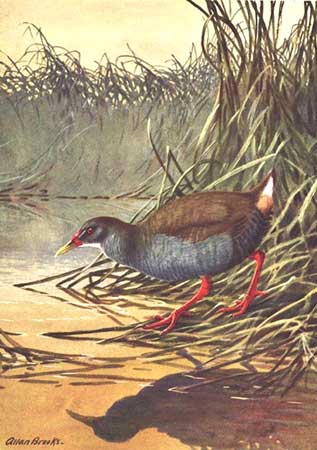
Fr: Râle de Zapata
Ang: Zapata Rail
All: Kubaralle
Esp: Polluela de Zapata
Ita: Rallo di Zapata
Nd: Zapataral
Sd: zapatarall
Illustrator :
Allan Cyril Brooks (February 15, 1869 – January 3, 1946)
Sources of this illustration :
From Wikimedia Commons, the free media repository
Dessin d'un Râle de Zapata par Allan Brooks, publié en 1928 chez Thomas Barbour dans The Auk.
Text by Nicole Bouglouan
Sources :
HANDBOOK OF THE BIRDS OF THE WORLD Vol 3 by Josep del Hoyo-Andrew Elliott-Jordi Sargatal - Lynx Edicions - ISBN: 8487334202
BIRDS OF THE WEST INDIES – by Herbert Raffaele, Kristin Williams et Tracy Pedersen – Helm – ISBN: 9780713649055
Wikipedia, the free encyclopaedia
Neotropical Birds – Cornell Lab of Ornithology
BirdLife International - Americas
Rare glimpse of elusive rail by Martin Fowlie, 2 Mar 2015
EcuRed – Conocimiento con todos y para todos
Nuevas localidades para la Gallinuela de Santo Tomás y la Ferminia
SORA – BARBOUR, Three Cuban Birds - NOTES ON THREE CUBAN BIRDS
Zapata Rail
Cyanolimnas cerverai
Gruiformes Order – Rallidae Family
INTRODUCTION:
The Zapata Rail is endemic to Cuba, and especially to the wetlands of Zapata Peninsula in SW Cuba. This species was discovered in March 1927 in the Zapata Swamp, by the Spanish zoologist Fermín Zanón Cervera.
The Zapata Rail was considered distinctive enough to merit its own genus Cyanolimnas.
It is restricted in the N part of the Zapata Swamp where two other species can be found, the Zapata Wren and the Zapata Sparrow.
The Zapata Rail has a very small population, still declining, threatened by degradation of the habitat and introduced predators. However, a recent sighting (November 2014) of an individual in the Zapata Swamp, indicates that this species is still present in this area.
The Zapata Rail is currently classified as Critically Endangered.
DESCRIPTION OF THE BIRD:
Biometrics:
Length: 29 cm
The Zapata Rail has very short wings and tail. It has mostly dark plumage overall, with brown upperparts and grey-blue underparts. Lower belly and rear flanks are darker and show indistinct pale grey bars, but the undertail-coverts are white, like chin and throat.
On the head, rear crown and nape are like the upperparts. Forehead, forecrown, face, head and neck sides are grey blue. We can see a short, white supercilium.
The fairly long bill is yellow with red base, more extended at base of upper mandible. The eyes are red. Legs and feet are red-orange.
Male and female are similar.
The juvenile is duller, without any red on the bill. Bill, legs and feet are mostly olivaceous.

RANGE:
The Zapata Rail is found in the Zapata Swamp in SW Cuba.
HABITAT:
The Zapata Rail frequents freshwater sawgrass marshes with bushes, small trees and cattails, but with sawgrass dominant (Cladium jamaicensis).
It favours habitats with flooded vegetation up to two metres tall, and mainly near higher grounds. The usual plant species are wax myrtle (Myrica cerifera), willow (Salix longipes), sawgrass (Cladium jamaicensis) and cattail (Typha angustifolia).
CALLS AND SONGS:
The Zapata Rail gives low, repeated call, similar to a bouncing ball “cutucutu-cutucutu-cutucutu”. It also produces short sounds such as “kuck kuck” similar to the Limpkin’s call that can be used as alarm call.
BEHAVIOUR IN THE WILD:
The Zapata Rail feeds among sawgrass. Its diet is unknown but usually, the rails living in marshes are omnivorous, feeding both on invertebrates and plant material. It probably feeds primarily on aquatic invertebrates.
The Zapata Rail is secretive and rarely seen. Its calls can be heard when the water levels are high, between November and February, during the breeding season. The rails are usually monogamous.
Like most Rallidae, it moves through the marshy vegetation, often crouching to avoid detection. When disturbed or threatened, it may run over short distance, then stopping while raising its short tail in order to display the white undertail-coverts.
The Zapata Rail is sedentary in Cuba.
It is virtually flightless, but the sighting of November 2014 reports that one rail was fluttering about three metres across a canal, flying with a tilt angle of the body of 40°.
REPRODUCTION OF THIS SPECIES:
The breeding season takes probably place between November and January/February.
Males in breeding conditions have been seen during this period, and juveniles are recorded in November and January.
The breeding biology of this species is poorly known. Only one nest was found, placed about 60 centimetres above the water in sawgrass, with three white eggs inside the nest. No more information.
The rails are monogamous. All species have precocial chicks that leave the nest soon after hatching. They are fed and guarded by both parents.
PROTECTION / THREATS / STATUS:
The Zapata Rail has very restricted range in Cuba. It is threatened by habitat destruction and introduced predators such as mongooses and rats. Because this rail nests close to water surface, the juveniles are preyed upon by exotic African catfish (Clarias gariepinus). In addition, the increase of tourists in this area is a future threat for this species.
The population is estimated to number less than 250 mature individuals (2009). This small population suffered significant decline since the year 2000. But declines of other rail species in Cuba have been reported too.
The Zapata Rail is currently classified as Critically Endangered.